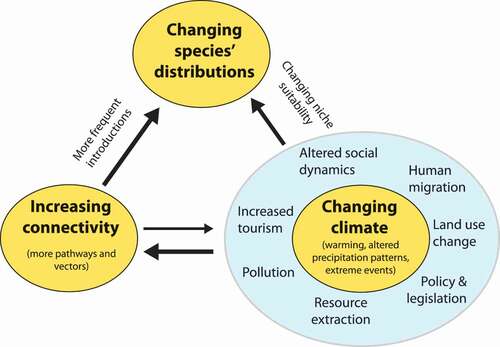Figures & data
Figure 1. More species are moving into higher elevations of mountains and higher latitudes because the changing climate is altering the availability of resources and shifting the fundamental niche space of plant species, which are responding by changing their distributions. Simultaneously, anthropogenic drivers associated with climate change (blue circle; number and movement of people, changes in land use, etc.) are increasing the connectivity to other systems, which in turn means that a wider diversity of species and propagules are being introduced to these regions. This will alter species distributions and allow for new interactions between species and human society, causing challenges to conservation and management of high-elevation and high-latitude, cold environments. Climate change, increasing connectivity and changing species distributions (yellow circles), and associated anthropogenic drivers (blue circle) are key topics discussed in this article

Figure 2. Alpine, Arctic, and Antarctic lands are experiencing plant species movements because of rapid climate change and increased human-mediated disturbance. We concentrate on the Arctic (dark blue; defined here as all land north of the Conservation of Arctic Flora and Fauna’s boundary line [dashed line]; CAFF and PAME Citation2017), the Antarctic (light blue; sub-Antarctic and Antarctic defined as all land south of the sub-Antarctic front [dashed line]; Orsi and Harris Citation2019; we concentrate on the Antarctic), and alpine areas (orange; depicted as elevations above 1,000 m in mountainous areas between the Arctic and Antarctic; UN-WCMC Citation2002)
![Figure 2. Alpine, Arctic, and Antarctic lands are experiencing plant species movements because of rapid climate change and increased human-mediated disturbance. We concentrate on the Arctic (dark blue; defined here as all land north of the Conservation of Arctic Flora and Fauna’s boundary line [dashed line]; CAFF and PAME Citation2017), the Antarctic (light blue; sub-Antarctic and Antarctic defined as all land south of the sub-Antarctic front [dashed line]; Orsi and Harris Citation2019; we concentrate on the Antarctic), and alpine areas (orange; depicted as elevations above 1,000 m in mountainous areas between the Arctic and Antarctic; UN-WCMC Citation2002)](/cms/asset/6e28fef2-d0af-4811-b5a4-f8e24c2f2493/uaar_a_1845919_f0002_oc.jpg)
Figure 3. Species are moving into high-elevation and high-latitude regions in response to the warming climate and other global change drivers. (Upper left) Ox-eye daisy invading subalpine grasslands in Kosciuszko National Park, Australia; the seed is dispersed by nonnative and native animals and humans. (Upper right) Nonnative pigs disturb native grasslands digging for tubers and bulbs, providing open sites for invasion, Kosciuszko National Park, Australia. (Lower left) Global climate change is increasing connectivity and recreation in arctic areas and the chance of undesired species movements. (Lower right) The warming climate and other global change drivers are intricately linked and impacting reindeer herding and human societies in the Arctic. Upper photos courtesy of Keith McDougall and lower photos by Jonas Lembrechts, University of Antwerp

Table 1. Nonnative vascular plant species observed in three or more alpine and arctic areas, and the Antarctic
